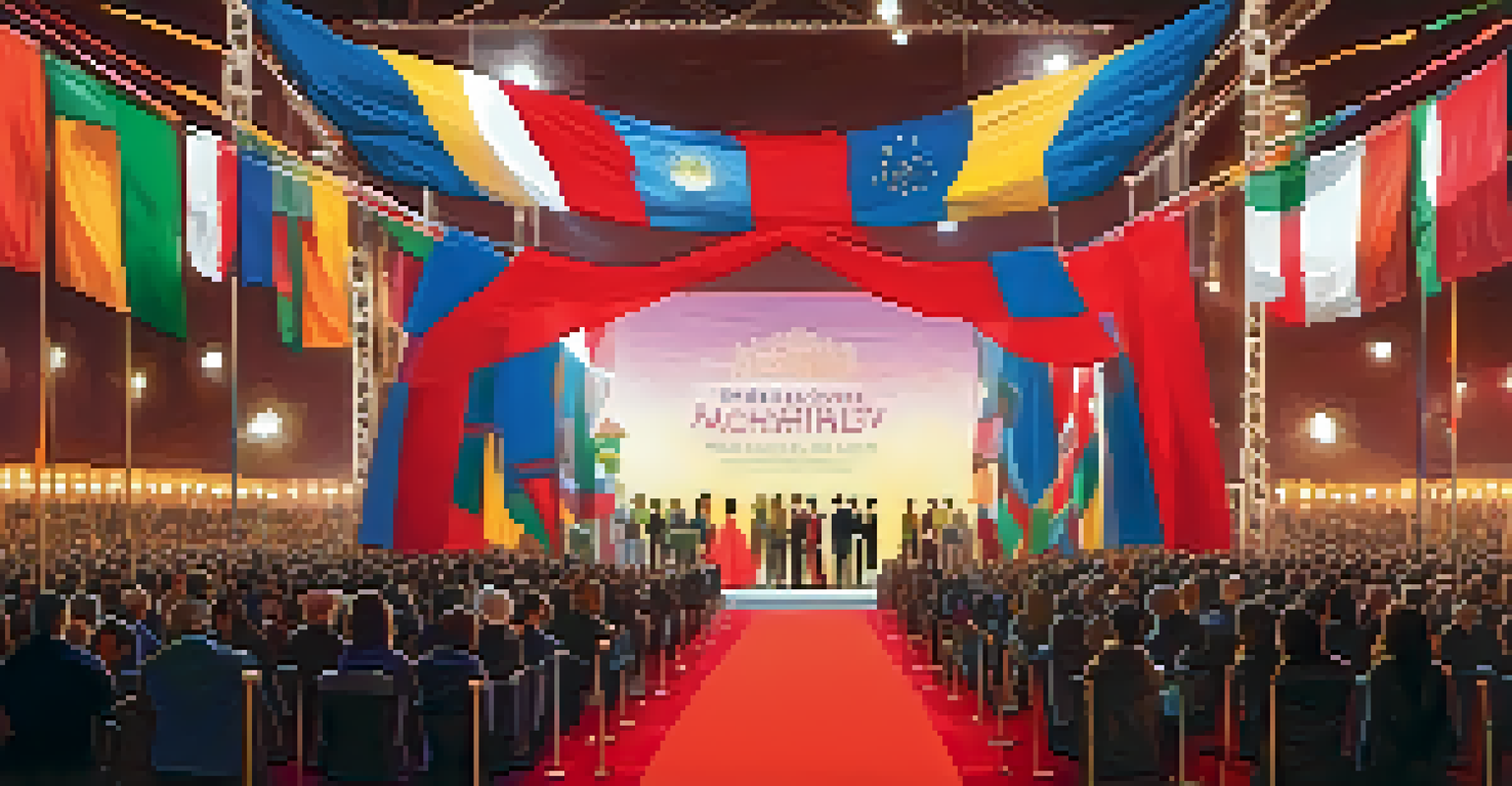The Evolution of Global Cinema Due to Hollywood Influence

The Early Days: Hollywood's Rise to Prominence
In the early 20th century, Hollywood emerged as the epicenter of film production, attracting talent from around the world. This new hub of creativity was characterized by its lavish studios, innovative techniques, and a focus on storytelling that captivated audiences. As silent films transitioned to 'talkies', Hollywood solidified its influence, setting standards for production quality and narrative style that would ripple across the globe.
Film is a powerful means of communication, a way to express and share our experiences, dreams, and struggles with the world.
The introduction of sound and color in films not only revolutionized the viewing experience but also propelled Hollywood to the forefront of the industry. Movies like 'The Jazz Singer' (1927) showcased the potential of synchronized sound, while advancements in color technology drew viewers in like never before. This global fascination with Hollywood films marked the beginning of an evolving relationship between American cinema and filmmakers worldwide.
As Hollywood's popularity surged, international markets began to adopt its styles and techniques, leading to a homogenization of cinematic language. Filmmakers from various countries started to emulate Hollywood's narrative structures and production values, seeking commercial success while grappling with their own cultural identities.
The Globalization of Film: A New Era
By the 1960s and 70s, the globalization of film became apparent, with Hollywood not just exporting movies, but also its culture and values. Cinema became a powerful medium for conveying the American way of life, drawing interest from audiences around the world. This period also saw the rise of major film festivals, which provided a platform for international films and facilitated cultural exchange.

As global cinema began to flourish, filmmakers outside of Hollywood started to carve out their own unique styles, often blending local traditions with Hollywood influences. For instance, the emergence of Bollywood in India showcased vibrant song-and-dance sequences, which were influenced by Hollywood musicals yet remained distinctively Indian in flavor. This blending of styles became a hallmark of global cinema.
Hollywood's Global Influence
Hollywood has shaped global cinema by exporting its styles, techniques, and cultural narratives, leading to a blending of local traditions with mainstream influences.
Moreover, the growth of television and home video expanded the reach of Hollywood films, allowing them to penetrate markets that were previously difficult to access. As audiences became more familiar with Hollywood storytelling techniques, local filmmakers often found themselves in a race to compete, leading to an interesting dynamic between local and global cinematic expressions.
Cultural Exchange: Influence and Adaptation
Hollywood has not only influenced the style and production of films worldwide but also the themes and narratives explored by international filmmakers. This cultural exchange has led to the adaptation of Hollywood’s storytelling methods in various contexts, enhancing the depth and diversity of global cinema. For example, many Asian filmmakers have incorporated Hollywood-style action sequences into their narratives while maintaining cultural authenticity.
Cinema is a matter of what's in the frame and what's out, and that is far more difficult than it looks.
This process of adaptation has resulted in hybrid films that often resonate with both local and global audiences. Movies like 'Crouching Tiger, Hidden Dragon' successfully blended traditional Chinese storytelling with Hollywood-style cinematography, capturing the attention of viewers worldwide. Such collaborations between cultures have enriched the cinematic landscape, showcasing the best of both worlds.
However, this influence is not without its challenges. Some critics argue that Hollywood's dominance can overshadow local cinema, pushing it to the margins. As a result, filmmakers are constantly striving to find a balance between adopting global trends and preserving their cultural heritage, leading to a vibrant dialogue within the film industry.
Technological Advancements: Changing the Game
The advent of new technologies has also played a significant role in the evolution of global cinema influenced by Hollywood. Innovations such as CGI, advanced sound design, and digital filmmaking have transformed the way stories are told on screen. These technologies, often pioneered in Hollywood, have been adopted by filmmakers around the world, allowing for a more visually compelling storytelling experience.
For instance, the use of visual effects has enabled international films to compete with Hollywood blockbusters in terms of production quality. Movies like 'Life of Pi' and 'Mad Max: Fury Road' have showcased how technology can elevate storytelling across diverse genres and cultures. This shift signifies a growing democratization of filmmaking, where access to technology is more widespread than ever before.
Cultural Exchange and Adaptation
Filmmakers worldwide are adapting Hollywood's storytelling methods while maintaining cultural authenticity, resulting in hybrid films that appeal to both local and global audiences.
Moreover, the rise of streaming platforms has further blurred the lines between Hollywood and global cinema. With platforms like Netflix and Amazon Prime producing content from various countries, filmmakers have unprecedented access to international audiences. This trend not only promotes diverse storytelling but also encourages collaboration and creativity among filmmakers across the globe.
Diverse Narratives: Expanding the Global Storytelling Lens
As Hollywood continues to influence global cinema, there has been a noticeable shift towards embracing diverse narratives and underrepresented voices. Filmmakers from various backgrounds are increasingly telling their stories, often drawing inspiration from Hollywood's success while ensuring their unique perspectives are highlighted. This has led to a richer cinematic landscape that reflects the complexities of our world.
Films such as 'Parasite' and 'Roma' have garnered international acclaim, breaking traditional storytelling molds and challenging stereotypes. These movies not only showcase local cultures but also resonate with universal themes, proving that audiences are hungry for authentic narratives. This evolution indicates a growing recognition of the importance of diversity in storytelling, both from Hollywood and global cinema.
Furthermore, the demand for diversity has prompted Hollywood itself to adapt, leading to a gradual shift in the types of stories being told. With increased representation in front of and behind the camera, the industry is slowly starting to reflect the diversity of its audience, which is crucial for its continued relevance in a globalized world.
The Challenge of Cultural Imperialism
While Hollywood's influence has undoubtedly enriched global cinema, it has also sparked debates around cultural imperialism. This term refers to the practice of promoting one culture over others, often resulting in the marginalization of local traditions and narratives. Critics argue that Hollywood's dominance can lead to a homogenized film landscape where unique cultural expressions are overshadowed by mainstream content.
This concern has prompted many filmmakers to actively resist Hollywood's influence, striving to preserve their cultural identities through film. For example, Iranian cinema has gained recognition for its poetic storytelling and strong social commentary, providing a counter-narrative to Hollywood's commercialism. This resistance highlights the ongoing tension between global trends and local traditions.
Challenges of Cultural Imperialism
The dominance of Hollywood raises concerns about cultural imperialism, prompting filmmakers to resist its influence and preserve their unique cultural narratives.
Moreover, the rise of independent cinema worldwide has provided a platform for filmmakers to explore stories that might not fit Hollywood's mold. By focusing on local issues and authentic experiences, these films challenge the prevailing narratives and offer fresh perspectives that resonate with audiences globally. This dynamic underscores the importance of preserving cultural diversity in cinema, even amidst Hollywood's overwhelming presence.
Looking Ahead: The Future of Global Cinema
As we look to the future, the influence of Hollywood on global cinema is likely to continue evolving. With advancements in technology and changing audience preferences, filmmakers around the world are finding new ways to tell their stories while being inspired by Hollywood's successes. This ongoing evolution presents exciting opportunities for collaboration and innovation across borders.
The rise of virtual reality (VR) and augmented reality (AR) in filmmaking is one such example, promising to reshape the narrative experience for audiences. Filmmakers can now explore immersive storytelling techniques that engage viewers in ways previously thought impossible. As these technologies become more accessible, we can expect a surge of creativity that reflects the diverse voices of global cinema.

Ultimately, the future of global cinema will be defined by a balance between Hollywood's influence and the preservation of local narratives. As filmmakers continue to navigate this landscape, they will likely forge new paths that honor their cultural identities while embracing global trends. This journey promises to enrich the cinematic experience for audiences everywhere, making cinema a truly universal language.